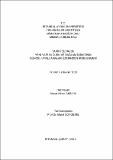Please use this identifier to cite or link to this item:
http://hdl.handle.net/11547/1816Full metadata record
| DC Field | Value | Language |
|---|---|---|
| dc.contributor.author | Akbıyık, Mimar | - |
| dc.date.accessioned | 2019-05-10T09:12:17Z | - |
| dc.date.available | 2019-05-10T09:12:17Z | - |
| dc.date.issued | 2013-02 | - |
| dc.identifier.uri | http://hdl.handle.net/11547/1816 | - |
| dc.description.abstract | Tarihi çevreler, geçmişte “yeni” olarak tanımlanıp, günümüzde “eski” olarak tanımlanan değerli yapıları içermektedir. Bu yapılar ait oldukları dönemin tüm sosyal, kültürel ,ekonomik ve teknolojik verilerini beraberinde getirmektedir. Tarihi çevredeki yapılar döneminin şartlarını anlamamızı sağlayarak, onları günümüzün ihtiyaçlarına cevap veren modern yapılarla birlikte değerlendirmemize yardımcı olmaktadır. Bu açıdan, tarihi çevrelerde yapılacak olan yeni yapılar, eski yapılarla ilişkili, günümüz mimarisini temsil edecek ve kullanıcının gerekliliklerine yanıt verecek şekilde tasarlanmalıdır. Bu çalışmada, ana amaç tarihi çevredeki yeni yapıları araştırmak ve günümüzde nasıl kullanılabileceklerini modern yapılarla nasıl birleştirilebileceklerini analiz etmektir. Bölüm 1’de, konu; çalışmanın amacı, kapsamı ve yöntemi belirtilerek açıklanmıştır. Bölüm 2’de, tarihi çevreyi korumanın amacı ve tarihi cevrenin bozulma nedeni, tarihi çevre kavramı tanımı geniş bir çercevede verilerek incelenmiştr. Bölüm 3’de, Tarihi çevrede yeni yapı oluşumu başlığı altında, mimaride eski ve yeni kavramlarının varoluşu ve günümüz yaşamı ile nasıl bütünleştiği açıklanmıştır. Tarihi çevrede yeni yapının tanımı, modern mimarlık kavramları ışığı altında incelenmiştir. Bu anlamda, tarihi çevrede bulunan yeni ve ek yapıların tasarı aşamasında hangi kriterlere sahip olması gerektiğine değinilmiştir. Tarihi çevrede yeni yapı tasarlarken kullanılan farklı yaklaşımlar – tarihi çevrede yeni yapı, mevcut yapıya ek, mevcut yapının yenileme ve dönüşümü başlıklarında açıklanmıştır. Bölüm 4’te, Mimaride yer, mekan, çevre ve bağlam kavramları ve bu kavramların ilişkileri incelenmiştir. Tarihi çevreye yaklaşımlarda yeni yapı bağlam ilişkisi / sentezi yapılırken konum, ölçek, doku, malzeme, renk, strüktür, biçim, işlev, sürdürülebilirlik kavramlarının tanımı yapılmıştır. Tasarımda kullanılan temel tasarlama biçimleri (öykünmesaygılı- zıtlık-taklit) açıklanırken, yapıları daha geniş perspektiften mercek altına almamızı sağlamıştır. Bölüm 5’te 2000 yılından itibaren tarihi çevre için yapılmış yeni yapı, yeni yapıya ek ve restorasyon projeleri, müdahale ve tasarlama biçimleri göz önünde bulundurularak seçilmiş ve analiz edilmiştir. | tr_TR |
| dc.language.iso | tr | tr_TR |
| dc.publisher | İSTANBUL AYDIN ÜNİVERSİTESİ FEN BİLİMLER ENSTİTÜSÜ | tr_TR |
| dc.subject | Tarihi çevre | tr_TR |
| dc.subject | Yeni yapı | tr_TR |
| dc.subject | Ek yapı | tr_TR |
| dc.subject | Çevre | tr_TR |
| dc.subject | Bağlam | tr_TR |
| dc.subject | Historical environment | tr_TR |
| dc.subject | New structure | tr_TR |
| dc.subject | Annex | tr_TR |
| dc.subject | Environment | tr_TR |
| dc.subject | Context | tr_TR |
| dc.title | TARİHİ ÇEVREDE YENİ YAPI OLGUSU VE BAĞLAM İLİŞKİSİNİN GÜNCEL UYGULAMALAR ÜZERİNDEN İRDELENMESİ | tr_TR |
| dc.type | Thesis | tr_TR |
| dc.description.abstractol | Historical environments include precious structures which were defined as a ‘new’ in the past but are defined as an ‘old’ today. These structures bring all social, cultural, economic and technological data from its period. They also make us understand circumstances of its period and these structures help us to evaluate them with modern structures which meet the requirements of today’s world. In this perspective, new structures which are going to be constructed in historical environments should be designed by connecting with old structures, representing of modern day architecture and, also, meeting requirements of human. In this study, main objective is research old structures and analyze how they can be used in today’s world and can be relevant to modern structures. In section 1, the subject is explained by stating objective, content and method of study. In section 2, the cause of protecting historical environment and the factor of deterioration of historical environment is examined by stating definition of historical environment concept in a wide perspective. In section 3, under the title of formation of new structures in historical environment, existence of ‘old’ and ‘new’ concepts in architecture and how they integrated to today’s conditions is clarified. Definition of new structures in historical environments is examined in the light of modern architectural conception. In this sense, the criteria which new and annex buildings in historical environment should have in the stage of design is referred. Intervention types of constructing new buildings in historical environment, which are new structure in old environment, annexation, restoration and transformation of existing structure, is elucidated. In section 4, concept of place, space, environment and context in architecture and their relations is explained. While environmentcontext relation in intervention of historical environment is synthesized, terms of location, scale, texture, material, color, form, function, sustainability is elucidated. Besides main design forms of intervention (simile, respectful, contrast, imitation) is clarified, these structures is analyzed in a wider perspective. In section 5, Projects of new structure, annexation and restoration which were designed for historical environment from 2000, are chosen and analyzed by taking into consideration of design and intervention forms. | tr_TR |
| dc.publisher.firstpagenumber | 1 | tr_TR |
| dc.publisher.lastpagenumber | 138 | tr_TR |
| Appears in Collections: | Tezler -Thesis | |
Files in This Item:
| File | Description | Size | Format | |
|---|---|---|---|---|
| 329412.pdf | Tez dosyası | 58.19 MB | Adobe PDF |  View/Open |
Items in DSpace are protected by copyright, with all rights reserved, unless otherwise indicated.
